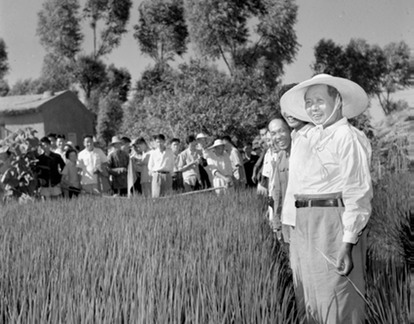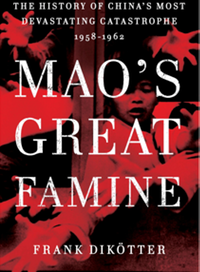The Sunday Times, 5 September 2010
A work of brilliant scholarship finally reveals the full extent of the horrors visited on the Chinese people by Mao during the Great Leap Forward
Few people outside China know much about the worst catastrophe in the country’s history — the great famine of 1958-62. Entirely man-made, and a direct result of the Great Leap Forward that was meant to transform China into a superpower, the calamity killed 45m people and was so swift, so huge and so horrific that the Communist party covered it up and the people willed themselves to forget it.
Testimonies about the famine have lain for decades yellowing in files and folders in local archives, waiting for researchers to unearth them. Travelling to some of the remotest corners of the country, and taking advantage of new laws that have opened up these archives to professional historians, Frank Dikötter, professor of the modern history of China at the School of Oriental and African Studies in London, has dug up hundreds of testimonies that finally reveal the full extent of the human tragedy unleashed on China’s people.
The Great Leap Forward was Mao Tse-tung’s mass campaign to overtake Britain in steel production and beat the Soviet Union in the race to perfect communism. Millions of Chinese stopped farming. The sky glowed red at night as their backyard furnaces turned out useless steel ingots. Millions more were ordered off the fields to labour on dams and reservoirs. Mao’s acolytes told him that China could do all this and multiply harvests many times over through socialist techniques. So the peasants were herded into communes, forced to give up private property, ordered to eat in communal kitchens, obliged to labour where and when the cadres ordered and, crucially, compelled to hand over their grain to the state.
To Mao, there was a stark purity about all this, but the book shows that the results were fatal. As grain stocks ran out, people took to eating tree bark, leaves and plants, until the landscape was stripped of vegetation. Villagers boiled leather until it was soft enough to be forced down. Eventually, people ate mud. Some were sufficiently strong to digest it and helped one another prise the solid faeces from their bodies. The weak, though, choked on it or died as it solidified in their guts. And, of course, people ate each other. They ate their neighbours, their elderly relatives and their children. Mostly, the archives tell us, the victims of these cannibals were already dead, but some, undoubtedly, were murdered. In one village an inspection tour by officials discovered a man simmering vats of human flesh.
As people lost every ounce of dignity, they resorted to unthinkable acts. They bartered everything, including their clothes, for scraps. In Shandong province, a man called Yan Xizhi gave away his three daughters because he could not feed them, then sold his five-year-old son for about £1 and his 10-month-old son for a pittance. Another father, Wu Jingxi, gave away his nine-year-old for the price of a bowl of rice and two sacks of peanuts. A mother, Wang Weitong, sold one of her sons for a few pennies and four steamed dough buns.
Such suffering need never have happened. Using meticulous documentation, Dikötter shows that, while millions were perishing in the worst-hit provinces of central and southern China, huge grain stocks remained locked up under government control. Meanwhile, trains carrying food trundled across the border into Siberia so that the People’s Republic could repay its fraternal debts to the Soviet Union. Mao wanted Russian technology, weapons and the atom bomb. Later, the party would peddle the lie that Moscow had forced China to pay up; in fact, Nikita Khrushchev, a veteran of the Ukrainian famines, offered help but was turned down by the Chinese, who feared a loss of face more than mass starvation.
The book describes in grim detail how violence was integral to the project. It was "a war on the people" waged with the same ruthless intensity that had swept Mao to power a decade earlier. The author calculates that among the 45m dead, 2.5m were beaten or tortured to death and between 1m and 3m committed suicide. Dikötter’s new statistics vindicate the estimates made by the pioneering journalist and writer on the famine Jasper Becker in the 1990s, when most records were still inaccessible. Mute for decades, the rural archives now speak of such things as the death of Tan Yunqing, aged 10, who was "drowned in a pond like a puppy" for having pilfered food in Mao’s home province of Hunan. Another boy in the same village stole a handful of grain and the local party chief, Xiong Changming, forced his father to bury him alive. The father died of grief.
It is hard to exaggerate the achievement of this book in proving that Mao caused the famine. Dikötter leaves no doubt that the Chinese leader qualifies as one of history’s great psychopaths, immune to the death and suffering of others. "It is better to let half of the people die so that the other half can eat their fill," he said. Dikötter does a fine job, too, in showing how the famine connected the Great Leap Forward of the late 1950s to the Cultural Revolution that would engulf China in the 1960s.
Thanks to him, the Chinese people now know the names of the guilty men, even though it is too late for retribution in most cases. One of them, Li Fuchun, finally summoned up the courage in 1960 to hand Mao a report about the "model province" of Henan, where 1m people had died, 67,000 of them clubbed to death by militias seizing their grain for the state. An investigation team found survivors weeping with despair surrounded by barren fields marked with graves. Ten infants, still breathing, had been "thrown into the frozen ground" in one village.
The famine finally ended when Mao gave in to the pleas of party leaders, stopped the utopian experiment and allowed the import of foreign grain. By then he had exploited the crisis to terrorise his rivals and to turn himself into the supreme leader of China.
Only a country as big and ancient as China could stagger under such blows yet still keep standing. Only a regime built on violence could survive them. And only thanks to brilliant scholarship such as this will the heirs of the vanished millions finally learn what happened to their ancestors.

